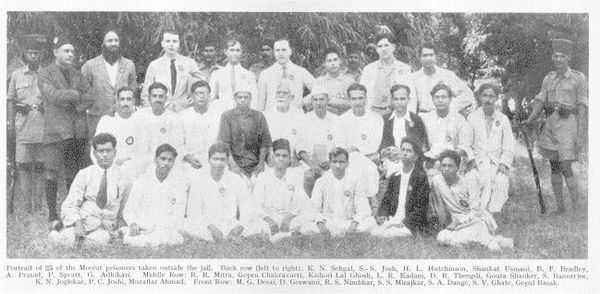Meerut Conspiracy Case

The Meerut Conspiracy Case was a controversial court case initiated in British India in March 1929 and decided in 1933. Several trade unionists, including three Englishmen were arrested for organizing an Indian railway strike. The trial immediately caught attention back home in England, inspired the 1932 play titled Meerut, by Manchester street theatre group the 'Red Megaphones', highlighting the detrimental effects of colonisation and industrialisation.[1]
Background
The British Government was clearly worried about the growing influence of the Communist International. Its ultimate objective, so the government perceived, was to achieve "complete paralysis and overthrow of existing Governments in every country (including India) by means of a general strike and armed uprising."[2] The government's immediate response was to foist yet another conspiracy case—the Meerut Conspiracy Case.
In more than one way the Meerut Conspiracy case trial helped the Communist Party of India to consolidate its position among workers. Dange along with 32 persons were arrested on or about March 20, 1929 [2] and were put on trial under Section 121A of the Indian Penal Code, which declares:
Whoever within or without British India conspires to commit any of the offenses punishable by Section 121 or to deprive the King of the sovereignty of British India or any part thereof, or conspires to overawe, by means of criminal force or the show of criminal force, the Government of India or any local Government, shall be punished with transportation for life,[3] or any shorter term, or with imprisonment of either description which may extend to ten years.
The charges
The main charges were that in 1921 Dange, Shaukat Usmani and Muzaffar Ahmad entered into a conspiracy to establish a branch of the Comintern in India and they were helped by various persons, including the accused Philip Spratt and Benjamin Francis Bradley, sent to India by the Communist International. The aim of the accused persons, according to the charges raised against them was under section 121-A of the Indian Penal Code (Act 45 of 1860)
to deprive the King Emperor of the sovereignty of British India, and for such purpose to use the methods and carry out the programme and plan of campaign outlined and ordained by the Communist International.
The Sessions Court in Meerut awarded stringent sentences to the accused in January 1933. Out of the accused 27 persons were convicted with various durations of 'transportation'. While Muzaffar Ahmed was transported for life, Dange, Spratt, Ghate, Joglekar and Nimbkar were each awarded transportation for a period of 12 years. On appeal, in August 1933, the sentences of Ahmed, Dange and Usmani were reduced to three years[4] by Sir Shah Sulaiman Chief Justice of the Allahabad High Court, on the grounds that the accused had already spent a considerable part of their sentence while waiting for the trial to be decided and because
in the case of political offenses, arising out of the beliefs of the accused, severe sentences defeat their object. In practice such sentences confirm the offenders in their beliefs and create other offenders, thus increasing the evil and the danger to the public.
Sentences of convicted others were also reduced.[2]
The convictions of Desai, Hutchinson, Mitra, Jhabwala, Sehgal, Kasle, Gauri Shankar, Kadara and Alve were also overturned in this appeal.
Impact of Meerut Conspiracy Case
Though all the accused were not communists, the charges framed against them betrayed the British government's fear for growth of communist ideas in India. In the trial the accused were all labeled as Bolsheviks. During the trial of four and a half years, the defendants turned the courtroom into a public platform to espouse their cause. As a result, the trial saw strengthening of the communist movement in the country. Harkishan Singh Surjeet, a former General Secretary of the Communist Party of India (Marxist) wrote about the aftermath of the Meerut Conspiracy case thus:
a Party with a centralized apparatus, came into being only after the release of the Meerut prisoners, in 1933. The Meerut Conspiracy Case, though launched to suppress the communist movement, provided the opportunity for Communists to propagate their ideas. It came out with its own manifesto and was affiliated to the Communist International in 1934.[5]
Further reading
- Meerut 1929-1932: Statement given in his own defence at Meerut Court, India, against a charge of " Conspiracy against the King " by Lester Hutchinson. Manchester Meerut Defence Committee, 1932.
- Meerut: Release the Prisoners! A Statement Upon the Meerut Trial and Sentences, by National Joint Council. Published by National Joint Council, 1933.
- Conspiracy at Meerut, by Lester Hutchinson. Ayer Publishing, 1972, ISBN 0-405-04154-3.
- Meerut Conspiracy Case & the Left-wing in India, by Pramita Ghosh. Published by Papyrus, 1978.
- The Great Attack: Meerut Conspiracy Case, by Sohan Singh Josh. Published by People's Pub. House, 1979.
- Meerut Conspiracy Case and the Communist Movement in India, 1929-35, by Devendra Singh. Published by Research India, 1990.
- Judgment on the Meerut Communist Conspiracy Case, by Meerut (India). Sessions Court, R. L. Yorke, Adhir Chakravarti, State Archives of West Bengal. Published by State Archives of West Bengal, Education Dept., Govt. of West Bengal, 1991.
References
- ↑ Meerut 1932 play, by Manchester street theatre group the Red Megaphones Working Class Movement Library.
- ↑ 2.0 2.1 2.2 "Meerut - the trial"
- ↑ During the British rule, a severe form of punishment was banishing convicts to a penal settlement in Andaman Islands.
- ↑ In S.H. Jhabwala And Ors. vs Emperor decided on 3 August 1933 AIR All 690 or 145 Ind Cas 481 http://indiankanoon.org/doc/1416180/
- ↑ Surjeet, Harkishan Singh 75th Anniversary of the Formation of the Communist Party of India, an article in The Marxist, New Delhi, Volume: 2, No. 1 Issue: January- March 1984
External links
- The Meerut Conspiracy Trial: Background, charges and sentences
- Meerut 1932 play, by Manchester street theatre group the Red Megaphones
| ||||||||||||||||||||||||||||||||||||||||||